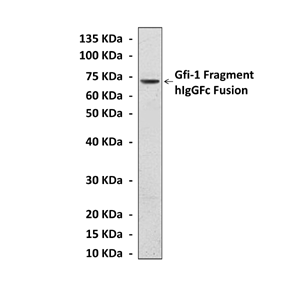Anti-Gfi-1: Mouse Gfi-1 Antibody
Mouse Gfi-1 Antibody: Mouse Gfi-1 Antibody
Size: 100 ul
Price: $413.00
Description
Gfi-1 functions mainly as a repressor of transcription. It represses its target genes by binding to consensus DNA elements containing the AATC core sequence. The Gfi-1 protein consists of an N-terminal SNAG domain required for nuclear localization, a central region and 6 C-terminal zinc fingers (ZFs) involved in DNA binding. The SNAG domain is important for transcriptional repression; however, Gfi-1 may repress transcription through both SNAG domain-dependent and independent mechanisms. The different domains of Gfi-1 have been implicated in recruiting corepressors and histone modifying enzymes, including eight-twenty-one (ETO), CoREST, histone demethylase LSD1, histone deacetylases (HDACs) 1 and 2, and the histone lysine methyltransferase G9a. The mechanisms by which Gfi-1 controls cell proliferation and survival are still poorly understood. It has been shown that Gfi-1 binds to and represses CDKN1A encoding the cyclin-dependent kinase inhibitor (CDKI) p21Cip, and the proapoptotic Bcl2 family member Bax. Myc-interacting zinc finger protein-1 (Miz-1) is a POZ-ZF transcription factor originally identified as a binding partner of c-Myc. Miz-1 possesses a potent anti-growth activity and has been shown to activate transcription by directly binding to the initiator (Inr) elements in its target genes, including Mad4, CDKN1A, and CDKN2B encoding the CDKI p15INK4B. It was shown that Gfi-1 interacts with Miz-1 and is recruited to the core promoter of CDKN2B via Miz-1, leading to transcriptional repression.3 In addition, Gfi1 functions as an antagonist of NF-kappaB activity at the level of promoter binding. This suggested a new function of Gfi1 as a general negative regulator of the endotoxin-initiated innate immune responses, including septic shock and possibly other severe inflammatory diseases.4
2. Hock, H. et al: Nature 431:1002-7, 2004
3. Basu, S. et al: Proc. Natl. Acad. Sci. USA 106:1433-8, 2009
4. Sharif-Askari,E. et al: Mol. Cell. Biol. 30:3929-42, 2010
Details
| Cat.No.: | CP10308 |
| Antigen: | Raised against recombinant human Gfi-1 fragments expressed in E. coli. |
| Isotype: | Mouse IgG1 |
| Species & predicted species cross- reactivity ( ): | Human |
| Applications & Suggested starting dilutions:* | WB 1:1000 IP n/d IHC n/d ICC n/d FACS n/d |
| Predicted Molecular Weight of protein: | 45 kDa |
| Specificity/Sensitivity: | Detects endogenous Gfi-1 proteins without cross-reactivity with other family members. |
| Storage: | Store at -20°C, 4°C for frequent use. Avoid repeated freeze-thaw cycles. |
*Optimal working dilutions must be determined by end user.
